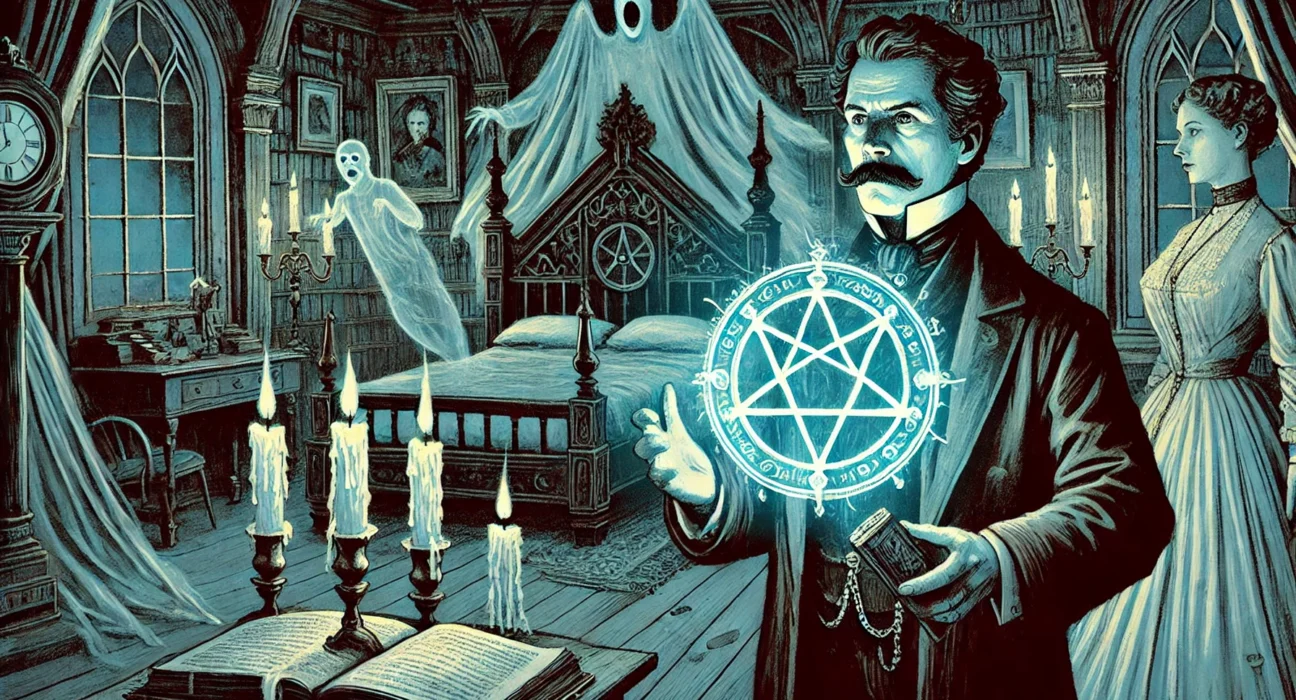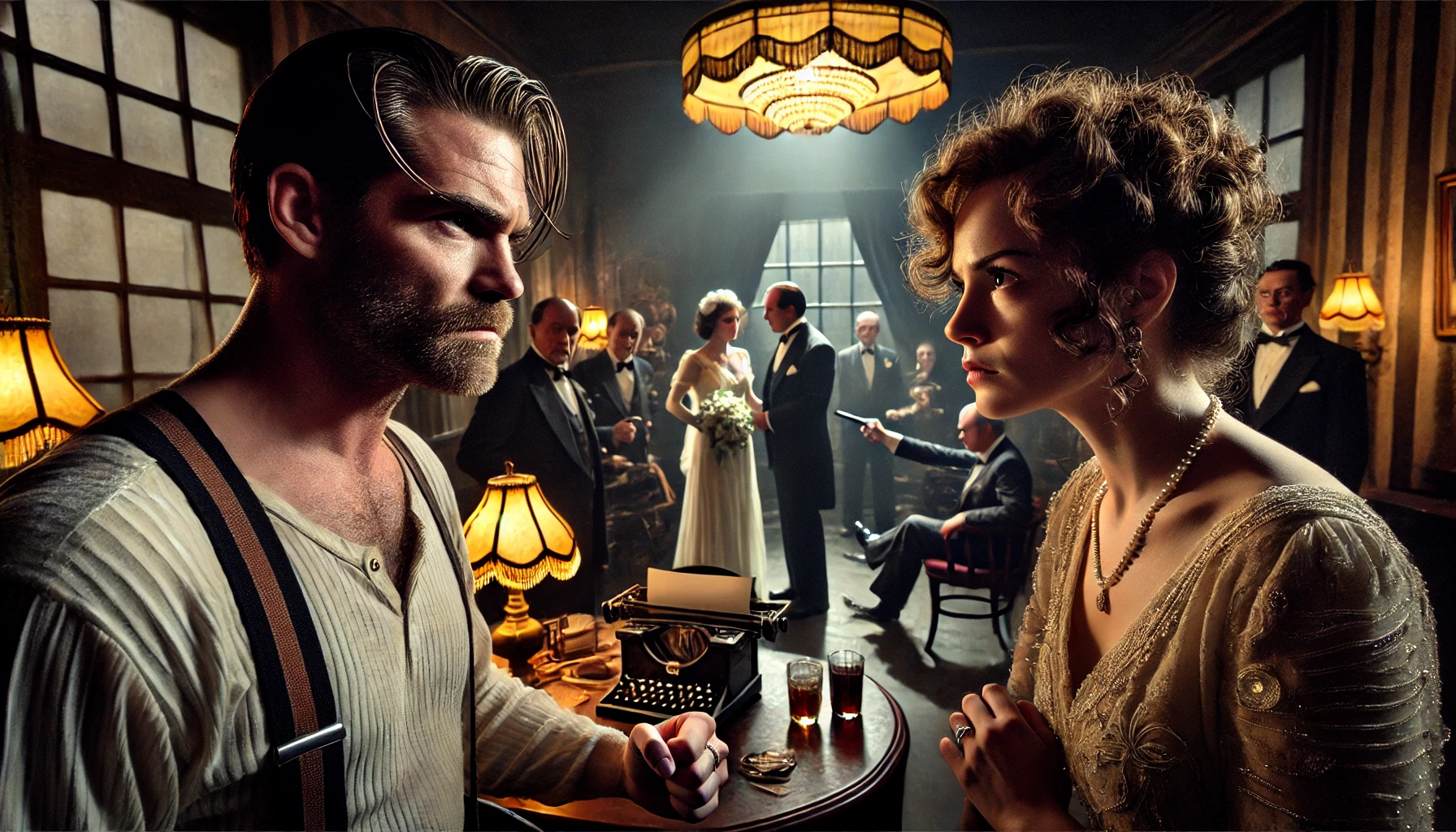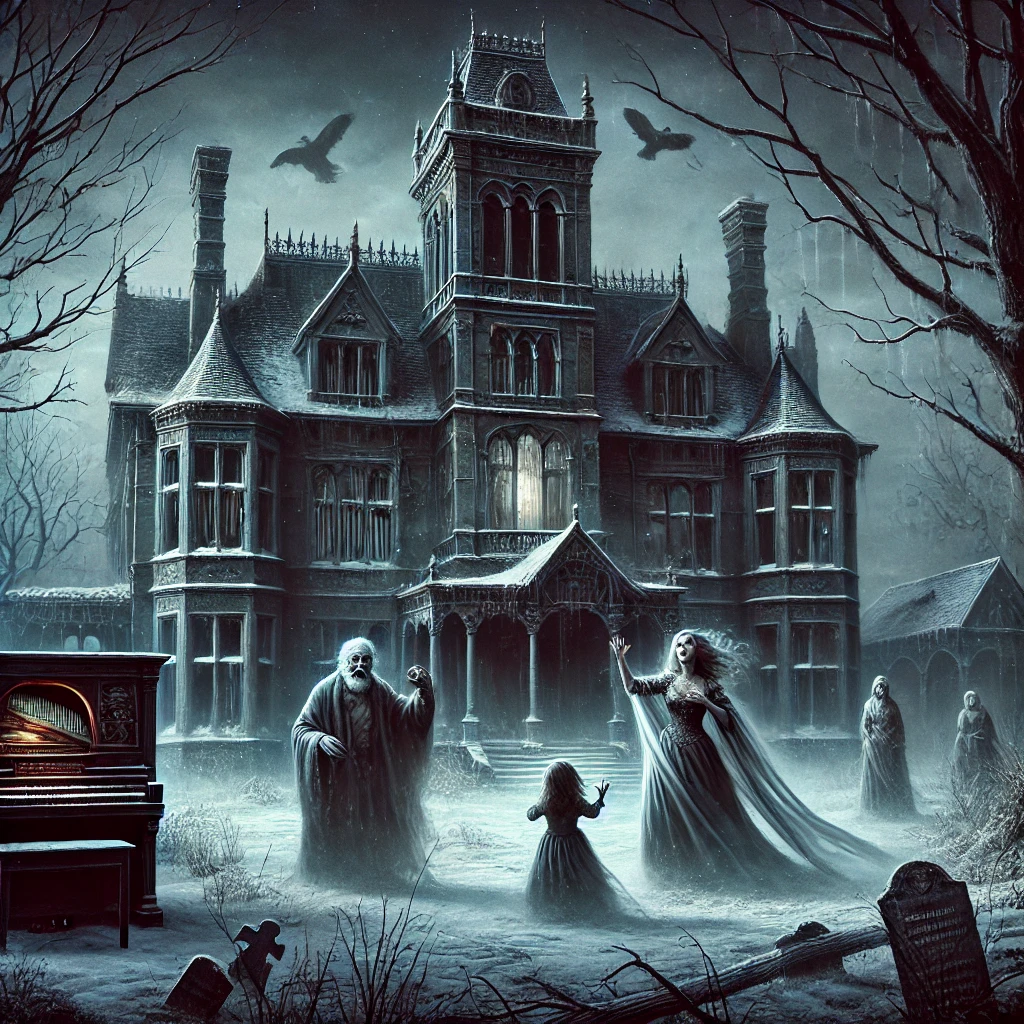Carnacki, The Ghost Finder is a collection of supernatural detective stories by William Hope Hodgson, published in 1912. Hodgson, an English author known for his works spanning horror, fantastic fiction, and science fiction, created the character Thomas Carnacki, an occult detective. The stories revolve around Carnacki’s investigations of various hauntings and supernatural occurrences, employing both scientific and mystical means to uncover the truths behind the eerie phenomena.
Plot Summary
Thomas Carnacki, the renowned investigator of the supernatural, was often called upon to delve into the dark and the inexplicable. One such instance led him to the infamous Grey Room, a place haunted by a sinister history. Anderson, the current owner of the house, implored Carnacki to solve the mystery behind the deaths that had plagued his family for generations. With a meticulous mind and an arsenal of both scientific instruments and occult knowledge, Carnacki set forth on his daunting task.
Upon arriving, Carnacki found the house to be an eerie, ancient structure, its walls whispering tales of tragedy and fear. Anderson had left, unable to bear the thought of spending another night within those walls. Only Peter, the loyal butler, remained, his face lined with the dread of the unknown. He spoke of doors that slammed shut in the dead of night and of bedclothes torn from the bed by unseen hands. Carnacki, however, remained unshaken. He set about preparing his defenses, using ribbons, seals, and the electric pentacle—a device he had designed to ward off supernatural entities.
Night fell, and the Grey Room seemed to pulse with a life of its own. A cold wind stirred the curtains, though no window was open, and the candles flickered as if a ghostly breath moved through the air. Carnacki sat in the center of his pentacle, eyes sharp and senses heightened. Suddenly, the door to the room slammed shut with a deafening thud, the noise reverberating through the house. Carnacki remained still, watching as the bedclothes were lifted and thrown into a corner by some invisible force. His heart pounded, but his resolve did not waver. Then he saw it—a monstrous hand, dark and grotesque, reaching out from the shadows. It moved towards him, but the electric pentacle held it at bay, the blue light forming an impenetrable barrier.
Carnacki realized that the haunting was connected to a small, pentagon-shaped ring hidden within the room, a relic tied to a curse that had brought death to Anderson’s ancestors. The ring served as a gateway, allowing the malevolent entity to cross into the mortal world. Carnacki destroyed the ring, the only way to sever the entity’s link and end its reign of terror. With the ring gone, the monstrous presence vanished, and the Grey Room returned to silence. The curse was broken, and Carnacki emerged victorious.
His adventures took him next to the desolate Gannington Manor in Ireland, recently inherited by his friend Wentworth. The manor stood shrouded in gloom, its windows darkened by years of neglect. Locals whispered of ghosts and a curse that haunted the estate. Wentworth, undeterred by these tales, decided to spend the night there, accompanied by a group of villagers and a bull-mastiff, offered by a concerned old man. As the evening descended into night, the manor’s true nature revealed itself. Strange apparitions flitted through the halls, and disembodied voices echoed in the darkness. The men, initially skeptical, soon found their courage waning.
Carnacki probed the manor’s history, uncovering the story of a hidden treasure and a family curse. The spirits that haunted Gannington Manor were bound to this treasure, their rest disturbed by the greed and violence that had surrounded its hiding. Using his knowledge of both science and the occult, Carnacki performed a ritual to cleanse the manor, breaking the curse and granting peace to the tormented souls. The oppressive atmosphere lifted, and Gannington Manor was left silent and still, its ghosts finally laid to rest.
In another case, Tassoc, the owner of a grand Irish mansion, sought Carnacki’s expertise to rid his home of a chilling phenomenon—the Whistling Room. This room, silent for years, had begun to emit an eerie whistling sound, an unnatural melody that grew louder with each passing night. Carnacki arrived and immediately sensed the room’s malignant aura. As he investigated, he realized that the room was more than just haunted; it was a living entity, an ancient evil that had made the room its lair. The whistling was its voice, a signal of its presence and its intent to harm.
Carnacki set up his electric pentacle and prepared for a confrontation. The entity within the room resisted, its whistling turning into a banshee-like wail. Objects in the room moved as if propelled by an unseen force, and the walls seemed to close in on themselves. Carnacki, with his protective measures in place, witnessed the entity’s manifestation—a dark, swirling vortex that seemed to pulse with malevolent energy. He managed to hold it at bay and advised Tassoc to seal the room permanently, warning that the entity within could never be truly destroyed, only contained.
Carnacki’s investigations also took him to the home of the Hisgins family, who were haunted by a spectral horse. The horse, an omen of doom, appeared whenever a family member was about to marry, a curse that had plagued the family for generations. The night of the impending wedding was filled with tension as Carnacki set up his detection devices around the house. The spectral horse made its presence known, its ghostly hoofbeats echoing through the halls, and its form occasionally visible, a shimmering, ethereal steed.
Through careful observation and the use of his instruments, Carnacki uncovered a human agent behind the hauntings. The spectral horse was a clever projection, a trick devised by someone seeking to manipulate the family through fear. By exposing the culprit and revealing the hoax, Carnacki lifted the curse that had tormented the Hisgins family, allowing them to live without the shadow of the spectral horse looming over them.
One of Carnacki’s most personal cases involved a house near his own residence, known as the End House. The house was steeped in sorrow, its walls echoing with the cries of a child who had died there many years ago. The child’s spirit had lingered, unable to find peace. Carnacki performed a cleansing ritual, using his electric pentacle to protect himself as he reached out to the spirit. He encountered the ghost of the child, a sad and lonely presence that yearned for rest. Through his ritual, Carnacki was able to guide the spirit to the afterlife, releasing it from its earthly bonds. The End House, once filled with an air of melancholy, was finally at peace.
Perhaps the most dangerous case Carnacki ever faced was that of “The Hog,” a grotesque and malevolent entity from another dimension. This entity had the power to invade dreams and possess the minds of its victims, driving them to madness and destruction. It had set its sights on one of Carnacki’s friends, tormenting him with horrific visions and compelling him towards self-destruction. Carnacki knew he was dealing with a force beyond any he had encountered before, a being of pure malice that sought to break through the barriers of reality.
Using every ounce of his knowledge and skill, Carnacki prepared for a confrontation. He constructed a fortified version of the electric pentacle, knowing that even the slightest error could mean his doom. The ritual began, and the room darkened as the Hog’s presence filled the space. Carnacki stood firm as the entity materialized—a grotesque, swine-like form that twisted and writhed in the air. It attacked with a fury that shook the very foundations of reality, but Carnacki’s pentacle held strong. The battle was intense, pushing Carnacki to the brink of his endurance. In the end, he managed to banish the Hog back to its own dimension, but the encounter left him scarred, a reminder of the terrifying forces that lurk just beyond the veil of the known world.
These investigations showcase the balance Carnacki strikes between science and the supernatural. His unwavering bravery and meticulous methods reveal the hidden truths behind hauntings, curses, and otherworldly entities. In his line of work, each victory is hard-won, and each case is a step further into the abyss, where logic meets the inexplicable and the unseen forces of the universe make their presence known.
Main Characters
- Thomas Carnacki: The protagonist, an occult detective who uses both scientific and mystical methods to investigate and resolve supernatural occurrences. Carnacki is methodical, brave, and knowledgeable in various fields of the occult and science.
- Anderson: A man who invites Carnacki to investigate the haunting of the Grey Room. He provides the initial details that lead Carnacki into the heart of the mystery.
- Peter: The loyal butler in “The Gateway of the Monster,” who assists Carnacki during his investigation despite his own fears.
- Wentworth: Carnacki’s friend in “The House Among the Laurels,” who inherits the haunted Gannington Manor and seeks Carnacki’s help in uncovering its mysteries.
- Tassoc: The owner of the haunted mansion in “The Whistling Room,” troubled by the strange whistling noises and ghostly presence.
- Hisgins Family: The family in “The Horse of the Invisible,” cursed by a spectral horse that appears before weddings. They seek Carnacki’s help to uncover the truth behind the hauntings.
Theme
- Rationality vs. Supernatural: Carnacki’s investigations often involve a blend of scientific reasoning and acceptance of supernatural phenomena, highlighting the tension between rationality and the unknown.
- Fear of the Unknown: The stories explore the primal fear of the unknown, with characters confronting terrifying and inexplicable occurrences that challenge their understanding of reality.
- Protection and Defense: Carnacki’s use of protective measures, such as the electric pentacle, symbolizes the need for defense against malevolent forces, both seen and unseen.
- The Past’s Influence on the Present: Many hauntings are linked to past events, curses, or tragedies, illustrating how history can cast long shadows over the present.
Writing Style and Tone
William Hope Hodgson’s writing style in Carnacki, The Ghost Finder is characterized by detailed descriptions and a methodical narrative approach. Hodgson meticulously outlines Carnacki’s investigative processes, blending scientific and mystical elements to create a sense of authenticity and believability. His tone is often suspenseful and eerie, effectively building tension and fear as the stories unfold.
Hodgson employs a first-person narrative, often through the voice of one of Carnacki’s friends, which adds a layer of intimacy and immediacy to the storytelling. The language is precise and formal, reflecting the early 20th-century setting, yet it is accessible and engaging. Hodgson’s ability to evoke a chilling atmosphere through vivid imagery and carefully paced revelations makes the stories compelling and immersive, drawing readers into Carnacki’s world of supernatural mysteries.
We hope this summary has sparked your interest and would appreciate you following Celsius 233 on social media:
There’s a treasure trove of other fascinating book summaries waiting for you. Check out our collection of stories that inspire, thrill, and provoke thought, just like this one by checking out the Book Shelf or the Library
Remember, while our summaries capture the essence, they can never replace the full experience of reading the book. If this summary intrigued you, consider diving into the complete story – buy the book and immerse yourself in the author’s original work.
If you want to request a book summary, click here.
When Saurabh is not working/watching football/reading books/traveling, you can reach him via Twitter/X, LinkedIn, or Threads
Restart reading!








